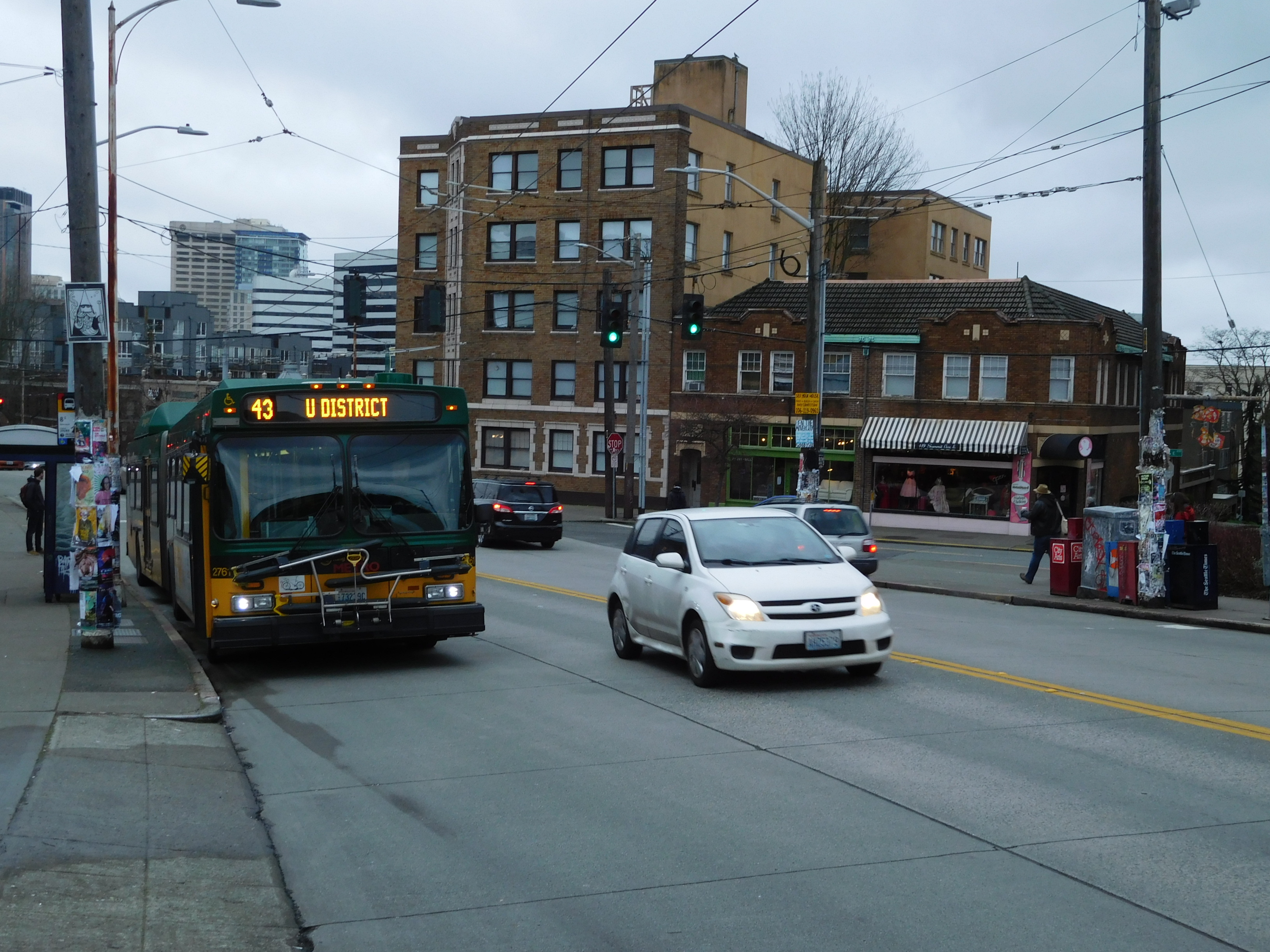

Capitol Hill is Seattle’s most dense and walkable neighborhood. Despite this there are a number of pedestrian trouble spots which should be fixed to improve the safety and quality of the street environment. A number of them are centered on Capitol Hill’s portion of Olive Way, one of the few east-west arterials that connects to Downtown. It’s also a transit street and home to many apartment buildings and retail, so it’s puzzling that the sidewalk conditions are so poor and that so many safe crossings are missing. Considering the upcoming Convention Center expansion and light rail station opening, this post gives the street a closer look and makes some short- and long-term suggestions for multi-modal improvements.
Street Profile and the Need for Fixes
Olive Way is the northernmost street in Downtown Seattle’s core grid. Within Downtown it is primarily a one-way eastbound street that carries general traffic and suburban commuter buses to Interstate 5 amid towering office buildings. It is one of a only a few streets that cross I-5. Climbing up Capitol Hill, the street becomes a smaller two-way facility among lowrise and midrise mixed-buildings. Here it also breaks from the grid layout and curves in an S-shape, crossing Denny Way and reconnecting to the grid at Broadway, Capitol Hill’s main commercial corridor. On the other side of Broadway, its name changes to John Street. Olive Way does not have any bicycle infrastructure.

Olive has a consistent right-of-way width of 66 feet. The roadway width (curb to curb) in the study area is 42 feet, equating to four lanes, except for the I-5 overpass where it is 35 feet and three lanes. On the west side of I-5, its average weekday traffic flow is only 10,100 vehicles, a very low amount for an urban street; the vast majority of this traffic occurs during the afternoon peak.

Below 9th Avenue Olive is a good street for pedestrians, having signalized intersections and well-maintained sidewalks and amenity zones. This proposal is concerned with the part of Olive between 9th Avenue and Broadway. I-5 divides this area into what I’ll call lower and upper parts.
The study area is timely because of the Washington State Convention Center (WSCC) addition. The $1.4 billion project will literally straddle Olive Way between 9th Avenue and Boren Avenue with a 440,000 square feet public facility on one side and 30 stories of private co-development on the other. This will add thousands of pedestrian and vehicle trips to Olive Way, so it is essential that the street be upgraded to meet the new demand and work safely for Seattle residents, employees, and visitors.
Because the WSCC will be vacating five public streets (most vacations involve just one), including a subterranean excavation beneath Olive, the developer will be required to provide a package of public benefits in return. Funding to retrofit Olive Way between 8th Avenue and Broadway must be a critical part of the benefit package. If the proximity were not enough, this is also in the WSCC’s best interests: its visitors will inevitably walk along Olive Way to the restaurants, entertainment, and other attractions of Capitol Hill — Pie Bar and Montana Bar are personal favorites! There will also be a clear connection between new automotive traffic and Convention Center events. A safe and attractive street will surely aid in drawing conferences and exhibitions.
The main features of the Olive Way upgrade would be:
- Converting the I-5 overpass to two-way traffic
- Channelizing the I-5 on- and off-ramps
- Rebuilding the worst sidewalks and improving curb ramps
- Adding sidewalk extensions and bus bulbs at intersections
- Adding a center left-turn lane and protected pedestrian crossings between Denny Way and Broadway
- Adding a traffic light at the Harvard Avenue intersection and upgrading the Summit Avenue intersection to a full signal
- Raising the Olive Way/Broadway intersection to sidewalk level and adding a pedestrian signal phase
I’ve heard, unofficially and unsourced, that the WSCC’s public benefits package will be valued in the wide range of $30-$80 million. A ballpark estimate for a complete rebuild of an urban street is $2-4 million per mile depending on the size of the street. The proposed benefit area is 0.7 miles long, and the proposal does not require substantial roadway repaving or utility upgrades, so I’ll conservatively peg the cost at $1 million.
Finally, this project would fit well within the scope of the Seattle’s Vision Zero plan. The goal of Vision Zero is to eliminate all serious injuries and deaths on Seattle’s streets by 2030. Fixing Olive Way would certainly contribute to that goal in a meaningful way: the current street design encourages high vehicle speeds and offers limited pedestrian crossing opportunities. Between 2007 and 2014 69 people walking and bicycling were hit by cars in the study area, an average of ten collisions per year. This proposal will effectively reduce the chance of death and serious injuries for the most vulnerable street users.
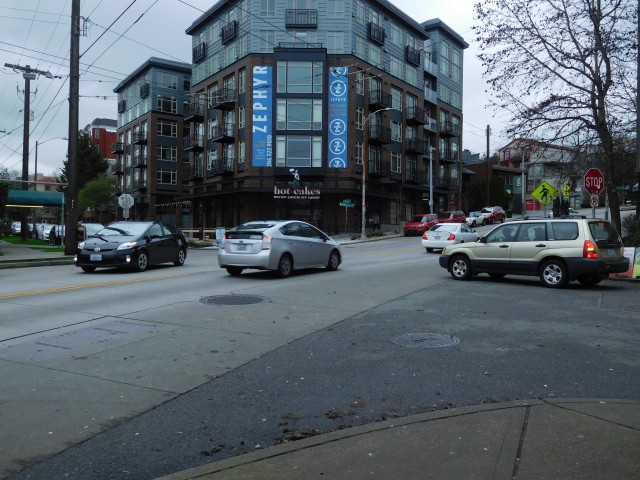
Sidewalks
The simplest aspect of the proposal is to rebuild the numerous sections of buckled and worn sidewalks on Olive Way. The worst conditions are between Bellevue Avenue and Boren Avenue, where it’s clear the concrete dates back at least 50 years and hasn’t had adequate maintenance. In some locations, the curb ramps are poorly located or have asphalt lips that can inhibit wheelchair users. Along with rebuilding the existing sidewalk alignments, sidewalk extensions would be useful in key locations to provide safe crossings and amenity zones for trees and bus stops. This is discussed more later on.
Two-Way Configuration
The key piece of the plan is to convert the I-5 overpass to two-way traffic. Traffic is one-way on the overpass, in the uphill direction, solely for the purpose of spitting cars and buses onto the freeway. As a result, drivers often floor it up the overpass with excessive speed. Converting the overpass to two-way operation will not only be consistent with the rest of the street, it will encourage slower traffic speeds, open up new opportunities for transit routing, and provide another option for drivers to get to Downtown. It will also make Olive more in line with its neighboring streets: the Denny Way, Pine Street, Boren Avenue, and Pike Street overpasses are also two-way.
Because the Olive overpass is only three lanes wide the conversion will, unfortunately, require eliminating a one-block High Occupancy Vehicle (HOV) lane. But this HOV segment is only 280 feet long, and Olive Way has a bus-only lane on most of its length during rush hour. The northbound commute is already a slog in the rest of Downtown and on the freeway, so eliminating this segment may not have much impact on northbound commuter routes. King County Metro and Sound Transit will doubtless want a detailed study to back this up, but a few seconds added to afternoon bus trips is worth the all-day benefits the overall redesign will bring. Plus, buses and carpools will still be able to use the HOV lane on the on-ramp itself.
With that said, there are other ways to ensure buses can get to the freeway quickly. One option is to extend the bus-only lane one block, between Terry and Boren, and add a bus-only light at Boren. This would allow buses to transition to the left-turn lane ahead of car
Freeway Ramps
The intersection of the northbound I-5 on- and off-ramps is perhaps the most poorly designed part of Olive Way. Streams of vehicles are encouraged to speed because of gently curving lanes that have no stop signs or signals. People walking have to fend for themselves. And there are three parallel parking spots awkwardly shoved into the mix in front of a grassy no-man’s-land.

The off-ramp connection is particularly bad because vehicles come around a blind corner, and neither drivers nor pedestrians have much chance to react if someone is not paying attention. The double lane on-ramp, at least, has a pedestrian-activated flashing signal that warns drivers someone is trying to cross the street, but in my experience it only has about 80 percent compliance.
The proposal totally rearranges this intersection to prioritize people walking and to encourage people driving to move slowly and carefully.
To begin with, the lower part of the on-ramp is closed, possibly providing space for a brand new pocket park. Cars headed to I-5 will use a dedicated left-turn lane at the Melrose Avenue intersection; cars will also be allowed to turn left onto Melrose, which is prohibited today. Because the one-block HOV lane is eliminated on the overpass, buses will also wait for the light in a single lane with cars.
The off-ramp is reconfigured so cars make a complete stop and give drivers a much clearer view of pedestrians; squaring up the intersection is also more compatible with pedestrians’ desire line. It may be possible to allow left-turns from the off-ramp, an attractive option for visitors headed to the Convention Center, but this would likely require a new traffic signal. Otherwise it can remain right-turn only.
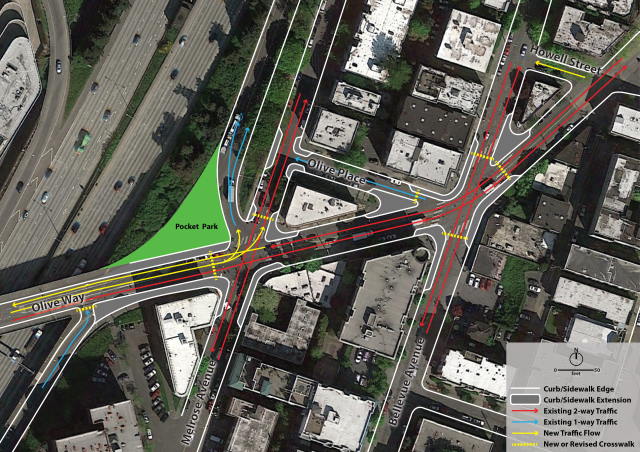
Rechannelization
The intersection of Olive and Bellevue Avenue is another problem spot. Though traffic lights are present, the angles created by Olive’s street grid mutiny present extremely long diagonal crosswalks. The size of the intersection makes it unclear when some cars are turning left, so pedestrians have to keep their heads on a swivel to avoid being hit. A similar issue is immediately adjacent at Olive Place, where drivers who can’t turn left at Melrose make a wide swing into a very long unmarked crosswalk.
As shown in the graphic above, sidewalk extensions could greatly reduce the size of the intersections and shorten crosswalks. It would make movements by both pedestrians and motorists more predictable. Because a number of bus routes use this intersection, the sidewalk extensions also provide more space for transit stop amenities. The large size of some of the extensions could also lend themselves to becoming informal plazas or event spaces. Sidewalks are always costly, so temporary interventions like paint, bollards, and planters could be installed to test out the design changes before permanent funding is made available.
The sharp corner from westbound Olive to northbound Bellevue will probably necessitate a right-turn prohibition, so the short block of Howell Street can be converted to one-way operations to facilitate that movement.
Safe Crossings
Olive Way is a difficult street to cross because many of its intersections are unsignalized. At Summit Avenue, the intersection is partially signalized, with a pedestrian-activated crosswalk light on one side that stops traffic only on Olive Way. There is no light for cars coming from Summit Avenue. I recommend making this intersection fully signalized.
The issue is particularly noticeable at the intersections with Minor, Belmont, and Harvard Avenues, which are heavily populated residential streets with no infrastructure for safe crossings. A bright spot is at nearby Boylston Avenue, where there is a painted crosswalk, warning signs, and a concrete refuge island in the center of the street. Space for the island is made possible because curbside parking is eliminated in the immediate vicinity.
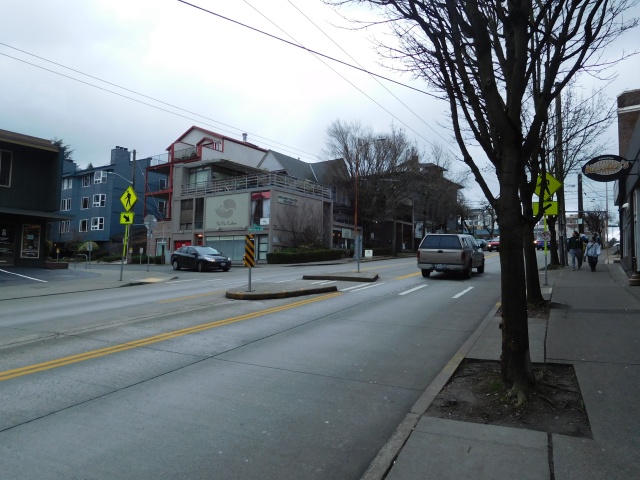
Along the rest of the street, the proposed solution is a center left-turn lane between Broadway and Denny Way. The center lane provides a safer opportunity for vehicles to turn left from Olive, getting them out of the traffic stream and decreasing the possibility of rear end collisions and swerving maneuvers. Equally as important, it provides space for more protected crossings like at Bolyston.
Adding a center turn lane requires removing at least one of the parking lanes. The next step depends on local decision makers and community demands, and I’ll refrain from making a strong recommendation. There are at least three exclusive options for the leftover space:
- Retain one lane of parking
- Install unprotected bike lanes on each side of the street
- Widen the sidewalks and amenity zones

The advantage of retaining parking is it allows for curb extensions on at least one side of the street at pedestrian crossings and bus stops, it preserves some automotive access to appease local residents, and it retains on-street loading space for business deliveries (though delivery trucks could also temporarily park in the center lane too).

The advantage of bicycle lanes, even if there is no space for a protective buffer, is that they would provide increased safety and comfort for people bicycling between north Capitol Hill and Downtown, they would encourage bicyclists to patronize local businesses, and they would provide an east-west connection to and from the Capitol Hill light rail station.

However, this option may be a tough political push because no adopted policies support it. Seattle’s Bicycle Master Plan does not plan for any bicycle facilities on Olive Way; instead, east-west protected bike lanes are planned on Pike Street. At either end of Olive, Pike Street can be reached by either the two-way protected bicycle lane on Broadway or the planned Melrose Avenue greenway. The argument could be made for bike lanes on upper Olive because they would fill somewhat a gap in the bicycle network, but the option needs to be studied further.

A third alternative would remove both parking lanes and instead widen the sidewalks and amenity zones to provide more space for walking, street trees, landscaping, furniture, public art, and other street amenities. This is perhaps the most appealing option in the interest of making Olive Way a more pedestrian-friendly street because it substantially narrows the roadway. However, moving the curbs would be a more expensive and time-consuming process that needs further review because of the potential impacts to utilities and drainage.
Moving along towards the end of Olive, I suggest fully signalizing the Harvard Avenue intersection with a new traffic light. The volume of cars and the frequency of turning cars is simply too great for people on foot and bike to comfortably cross during most of the day.
Light Rail Connection
One block over at Broadway, a dedicated left-turn lane and a third signal phase is sorely needed. Oftentimes only one or two left-turning cars from a long queue can make it through the intersection. The third signal phase could either be for left-turning vehicles, or it could be a pedestrian-only phase.
The Capitol Hill light rail station, opening in March, will greatly increase the already-high amount of foot traffic at this intersection. As a further step, the intersection should be raised to curb-level (known as a tabletop) to prioritize pedestrians and bicyclists. This would also make the intersection a giant speed bump, encouraging drivers to drive slowly while physically elevating pedestrians. Some communities have used tabletop intersections as an opportunity for public art or decorative paving.

Transit
Today the all-day bus routes that use upper Olive Way are the 8 and 43. They both run every 15 minutes throughout the day, meaning the street sees at least 16 buses per hour; the route 47 also provides sporadic and infrequent service throughout the week. The high frequency service on upper Olive merits a close look at what a street fix can do for transit.
Anecdotally, buses move fairly well on the upper part of Olive Way. If anything, the most common cause for delay at the Summit and Harvard stops is being stuck in the curb lane and waiting for an opening to merge back into traffic. If on-street parking remains, additional curb extensions at the stops could relieve this on both Olive Way and nearby stops on Bellevue Avenue. This would allow buses to stop in the travel lane and move forward as soon as they finish loading and unloading passengers.
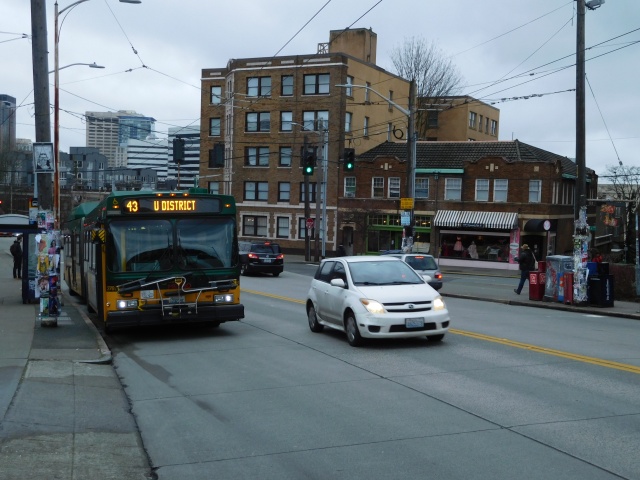
In March, the 43 will be reduced to peak-only service. To make up for this King County Metro will realign the route 10 from Pine Street (shown in the map below), which runs even more frequently. The 10, along with the 11, 43, 49, and 47, contributes to a gluttony of bus service on Downtown’s Pike/Pine corridor. When I sat on the U-Link Sounding Board, I actually heard a number of pleas for reducing service on Pike/Pine in order to better serve other streets and destinations. As mentioned earlier, making the Olive Way overpass a two-way street opens up the possibility of a slightly more direct route to Downtown that both relieves pressure on Pike/Pine and provides new service to the Convention Center expansion site.
This could happen with yet another realignment of the route 10, or perhaps the lower frequency 43 and 47. Whichever route, in the westbound direction the line would need to turn off Olive because the street is one-way eastbound beyond Terry Avenue. The best routing into the rest of Downtown is Stewart Street, which is already a major bus corridor. Terry Avenue is going to be de facto vacated by the Convention Center expansion for freight and passenger loading, so getting to Stewart via Boren makes the most sense. In the other direction, the bus would use the transit-only and general traffic lanes Olive Way. New trolleybus wire would be needed on Boren and the lower part of Olive.
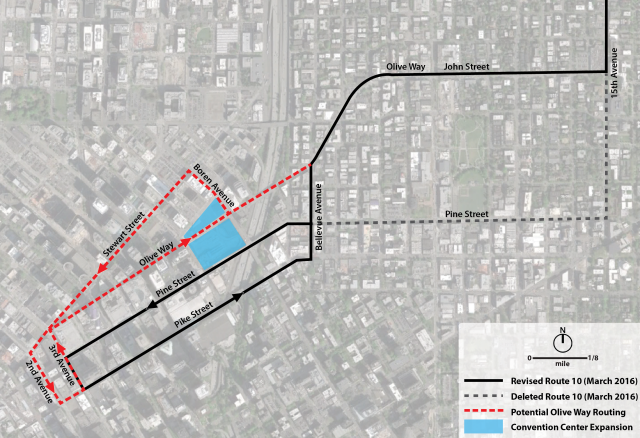
Conclusion
The changes presented here, taken in full or in part, would make Olive Way much safer for all users and reduce barriers between Capitol Hill and Downtown.
The top priorities are to rearrange the freeway ramps, convert the I-5 overpass to two-way traffic, and repair sidewalks. These fixes are the most immediately feasible because they are within the three-block range of typical street vacation benefit areas. But because the WSCC will be vacating not one, but five streets, it is conceivable that the scope for public benefits could include more of Olive Way up to Capitol Hill. This makes the street rechannelization, safe crossings, and extended sidewalks a feasible part of the benefit package. It also makes sense as part of funding for Vision Zero improvements because Olive Way will soon see an influx of new foot traffic with the opening of the Capitol Hill light rail station next month.
Let’s work together to make Olive Way a safer and more harmonious street for all users. If this proposal interests you get in touch with the Seattle Design Commission, which will make recommendations on the WSCC’s public benefit package, and the Seattle City Council, which will make the ultimate decision on the street vacation. You can also suggest improvements to the Seattle Department of Transportation. Stay tuned for future updates on the WSCC addition and further efforts to bridge the gap over Interstate 5.
This article is a cross-post from The Northwest Urbanist.
Scott Bonjukian has degrees in architecture and planning, and his many interests include neighborhood design, public space and streets, transit systems, pedestrian and bicycle planning, local politics, and natural resource protection. He cross-posts from The Northwest Urbanist and leads the Seattle Lid I-5 effort. He served on The Urbanist board from 2015 to 2018.

